Alpine Chough
- October 26, 2023
- 0 comment
The Alpine Chough, scientifically known as Pyrrhocorax graculus, is a captivating bird species that belongs to the crow family. One of its most remarkable attributes is its unique ability to nest at higher altitudes than any other bird. In this extensive exploration, we’ll delve into the physical attributes, behavior, ecological significance, and much more that make the Alpine Chough a truly fascinating species.
Physical Appearance
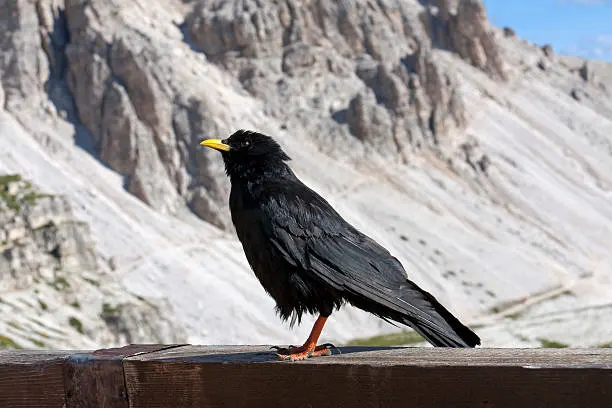
The Alpine Chough
- Lifespan: Up to 23 years.
- Habitat: High altitudes in mountainous regions
- Diet: Worms, snails, insects, berries, sometimes dead animals and organic waste
- Size: 13.4-15 inches long
- Weight: Males 6.8-9.8 ounces, females 5.6-9 ounces
- Wingspan: 30-33 inches
- Conservation Status: Least Concern.
- Population Trend: Climate change may pose long-term challenges by pushing their habitat to higher altitudes.
The Alpine Chough is a medium-sized bird, measuring approximately 37-39 cm in length and possessing a wingspan spanning 75-85 cm. These birds weigh between 188 and 252 grams, making them relatively lightweight compared to their larger crow relatives.
Feather Coloration
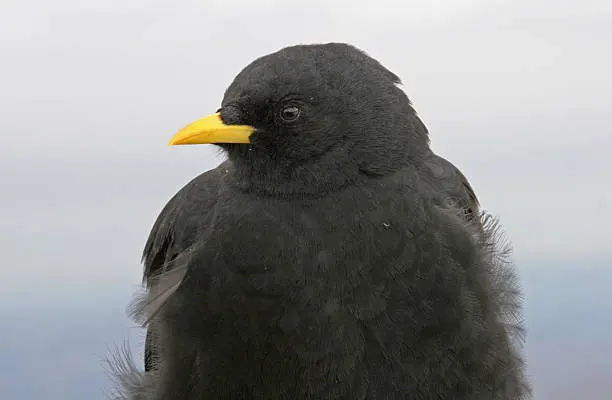

The Alpine Chough is easily identifiable by its glossy black plumage, which gives it a striking and elegant appearance. However, it’s worth noting that young Alpine Choughs exhibit slightly different coloration. These juveniles have duller plumage, a dull yellow bill, and brownish legs. This distinction is a key factor in distinguishing the age of these birds.
Species Type
The Alpine Chough’s taxonomic classification is a fascinating aspect of this bird’s identity. It belongs to the genus Pyrrhocorax, a genus that consists of only two species. This rarity in the number of species within a genus is quite distinctive in the bird world.
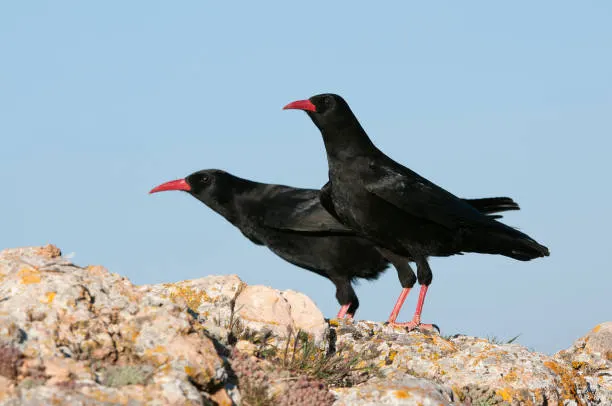
The genus Pyrrhocorax is characterized by birds commonly known as choughs, which are medium-sized members of the crow family. The Alpine Chough shares this genus with its close relative, the Red-billed Chough (Pyrrhocorax pyrrhocorax). These two species, despite their similarity in genus, display their unique adaptations and behaviors, particularly in their nesting habits and vocalizations.
The Alpine Chough’s taxonomic placement within this limited genus showcases its distinct evolutionary path and adaptations that have allowed it to thrive in the high-altitude environments of mountainous regions. This unique taxonomic position offers valuable insights into the diversity of adaptations that can occur even within closely related species, making it a subject of interest for researchers and ornithologists studying avian evolution and ecology.
Flight Characteristics
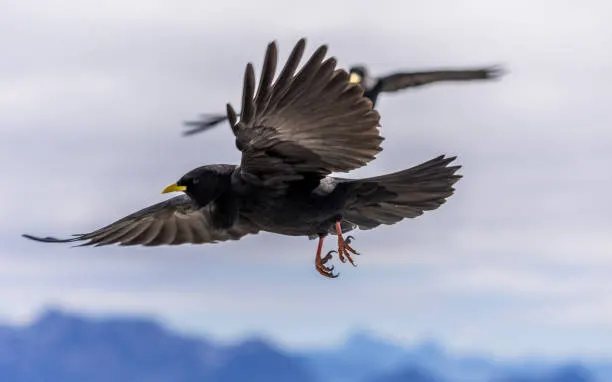
When it comes to flight, the Alpine Chough is a true acrobat of the skies. Their flight is swift and highly maneuverable, characterized by loose deep wing beats. They achieve remarkable agility by fanning their tails, folding their wings, and skillfully soaring in the updrafts found at cliff faces. This ability to navigate through challenging mountainous terrain sets them apart in the avian world.
Habitat & Distribution
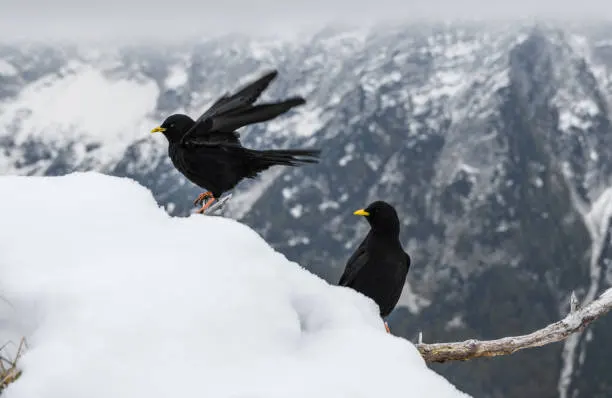
Alpine Choughs are mountain dwellers, thriving in high-altitude environments. Their breeding range spans from Spain eastwards through southern Europe and North Africa to Central Asia and Nepal. In addition to these regions, they also have populations in other mountainous areas, including Morocco, Corsica, and Crete. These birds have adapted to some of the most rugged and remote landscapes on Earth.
Migration Patterns
Migration Patterns of the Alpine Chough present a unique contrast to the long-distance migrations commonly observed in many bird species. Unlike birds that embark on extensive journeys spanning continents, Alpine Choughs are primarily resident birds within their designated range. Their behavior is characterized by localized altitudinal movements, rather than lengthy migrations.
In essence, these birds are mountain-dwelling homebodies. They remain within their mountainous habitat year-round, with their movements dictated by the changing seasons and the altitude of their chosen residence. This behavior is in harmony with their specialization in high-altitude environments and their adaptation to the challenging conditions presented by mountain life.
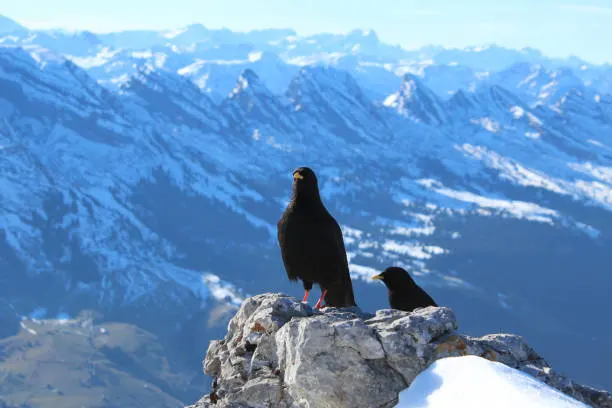
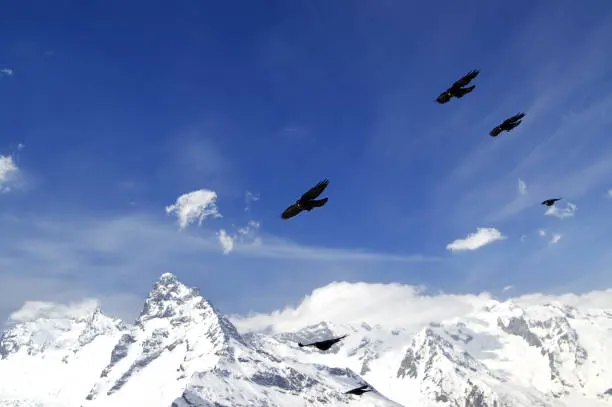
As the seasons transition, the Alpine Chough responds by adjusting its altitude within the mountainous terrain. During the colder months of winter, when high-altitude regions become more inhospitable due to extreme cold and reduced food availability, these birds perform a downward shift in elevation. They descend to lower altitudes in search of more temperate conditions and additional food sources.
Conversely, as spring arrives and the high-altitude regions become more favorable, they make their way back up the mountains. This localized altitudinal migration is a testament to their adaptability and their ability to thrive in harsh, high-altitude environments.
Unlike many migratory birds, Alpine Choughs don’t undertake lengthy journeys across vast distances. Instead, they have mastered the art of vertical migration within their mountainous domain, ensuring their survival in the face of challenging seasonal changes. This unique pattern of movement reflects their specialization and remarkable adaptation to their rugged and remote habitat. It also highlights the importance of understanding the diverse strategies that birds employ to cope with environmental fluctuations.
Behavioral Traits

Alpine Choughs are highly social birds, living in flocks that can range in size from a few individuals to over a hundred. These flocks are typically composed of a mix of sexes and ages, and they are very close-knit. Alpine Choughs will often forage together, roost together, and even travel long distances together.
There are several reasons why Alpine Choughs are so social. First, living in a flock provides protection from predators. When a predator is spotted, the entire flock will often raise an alarm call and band together to drive it away. Second, foraging in a group is more efficient. Alpine Choughs often use their beaks to dig for food, and they can share the task of digging with other members of the flock. This can help them to find food more quickly and easily. Third, living in a flock can help Alpine Choughs to maintain their body temperature. These birds live in cold, high-altitude environments, and they huddle together to stay warm.
The social nature of Alpine Choughs is also evident in their mating behavior. These birds typically mate for life, and they will often build their nests close to each other. Alpine Choughs also cooperate in raising their young. Both the male and female will help to build the nest, incubate the eggs, and feed the chicks.
The fact that Alpine Choughs maintain a relatively consistent flock composition throughout the year is also interesting. This suggests that these birds have strong social bonds with each other. It is possible that Alpine Choughs recognize each other individually, and that they form close friendships with other members of their flock.
Role in Ecosystem
Alpine Choughs play a crucial role in the ecosystems they inhabit, particularly in the mountains. These birds are scavengers and serve as nature’s cleanup crew. By consuming dead animals, they help in the decomposition process and also aid in disease prevention. In the challenging high-altitude environments where they reside, the Alpine Chough’s presence contributes to the overall health and balance of the ecosystem.
Dietary Habits
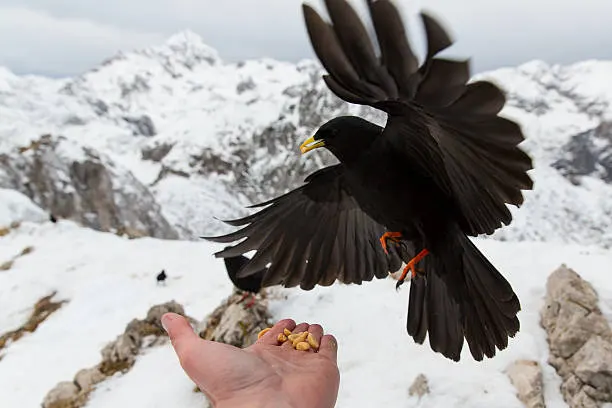
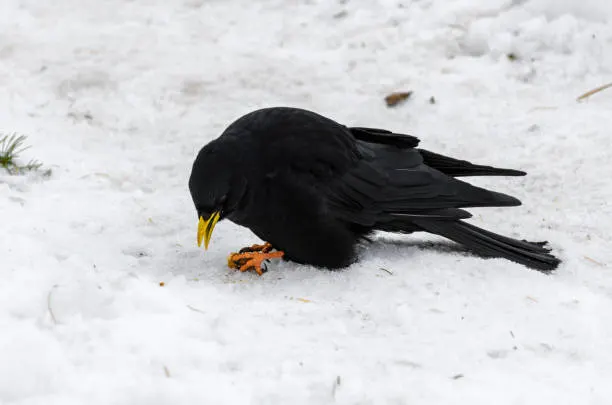
These birds are omnivores, with their diet shifting with the changing seasons. During the summer, they primarily feed on invertebrates, such as beetles, snails, grasshoppers, caterpillars, and fly larvae. However, as autumn, winter, and early spring arrive, their diet transitions to mainly fruit. They feed on berries, rose hips, and, interestingly, domesticated crops like apples, grapes, and pears where available.
Interesting Facts
The Alpine Chough boasts several remarkable and intriguing characteristics. One of the most extraordinary facts about this bird is its nesting behavior. These birds nest at altitudes higher than any other bird species. This exceptional adaptation to extreme environments has captured the fascination of researchers and bird enthusiasts alike.
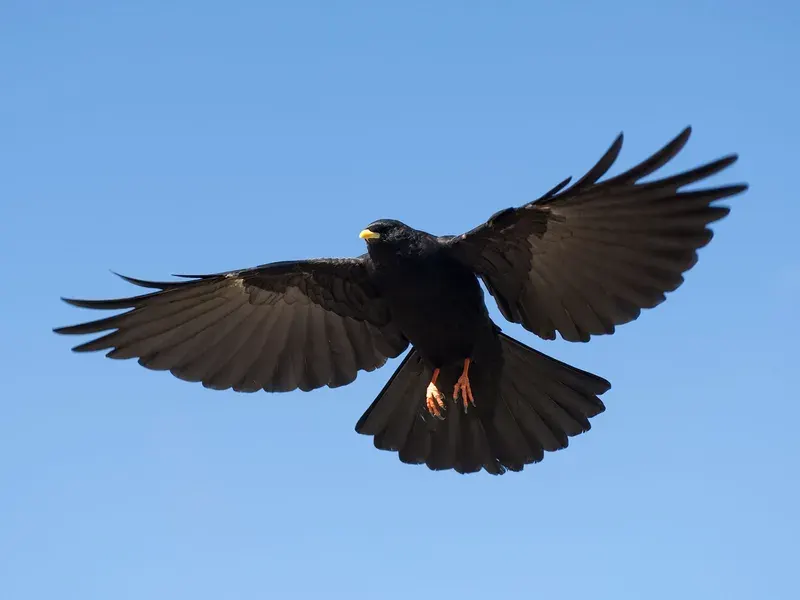
Additionally, their flight patterns are a true marvel of nature. Alpine Choughs showcase their high maneuverability in the air by employing unique techniques such as tail fanning and wing folding. They are known for soaring in the updrafts at cliff faces, making them a spectacle to witness in their mountainous habitats.
- Communication with flock members: Alpine Choughs use a variety of calls to communicate with each other, such as alarm calls, contact calls, and mobbing calls. Alarm calls are used to warn other flock members of predators. Contact calls are used to maintain contact with other flock members, especially when foraging in dense vegetation. Mobbing calls are used to harass predators.
- Mate attraction: Alpine Choughs also use vocalizations to attract mates. Male Alpine Choughs will often sing a complex song during the breeding season. This song is thought to advertise the male’s fitness and quality to potential mates.
- Territorial defense: Alpine Choughs also use vocalizations to defend their territories. Male Alpine Choughs will often sing from high vantage points to deter other males from entering their territory.
Nesting Habits
Alpine Choughs are known for their bold choice of nesting sites. They typically nest in cavities and fissures on inaccessible rock faces. These locations provide them with protection from potential ground-based predators, ensuring the safety of their young. In some instances, they may even use holes between rocks in fields, displaying their adaptability in finding suitable nesting spots.
Vocalizations & Sound Mimicry
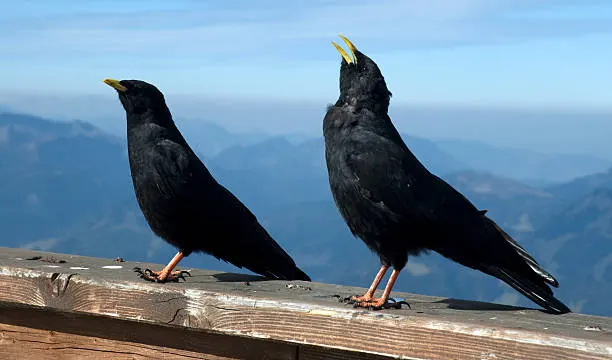
While the vocalizations of the Alpine Chough have been studied, it’s important to note that there is much more to discover about their communication methods and their significance in their social behavior. Research into their vocalizations is ongoing and promises to unveil additional insights into their unique communication.
Ecological Significance
One of the most astounding ecological features of Alpine Choughs is their ability to nest at extreme altitudes. They have been documented nesting at elevations as high as 6,500 meters (21,300 feet). This remarkable adaptation allows them to inhabit some of the most challenging and inhospitable environments on the planet.
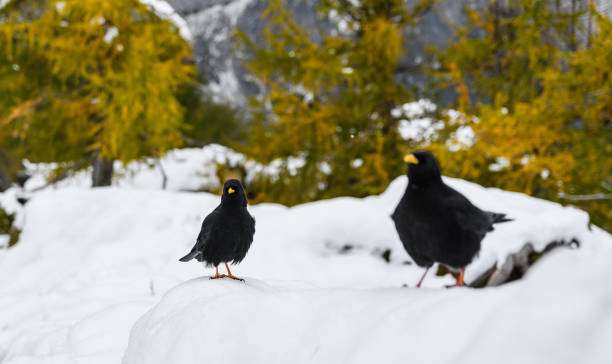
Furthermore, Alpine Choughs exhibit intriguing foraging behavior. They hide their food in cracks and fissures, concealing their caches with a few pebbles. This behavior not only demonstrates their intelligence but also has ecological implications as it can impact seed dispersal and vegetation growth in high-altitude regions.
Conservation Status and Challenges
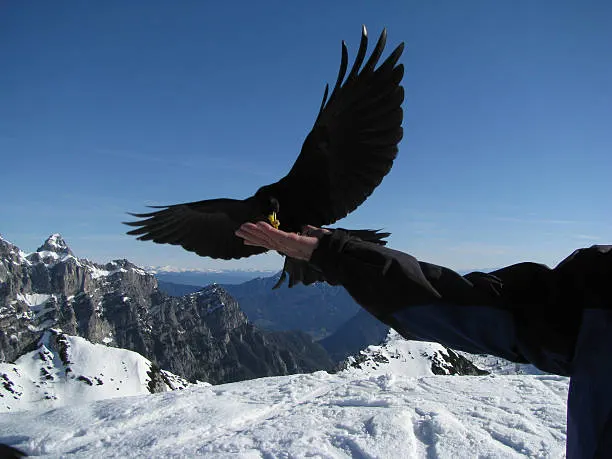
The Alpine Chough, despite facing predation and changes in agricultural practices that have caused local population declines, is not globally threatened. However, there are long-term concerns, particularly related to climate change. Shifting climate patterns may alter the necessary Alpine habitat, pushing these birds to higher altitudes and posing challenges to their survival.
Research and Ongoing Studies
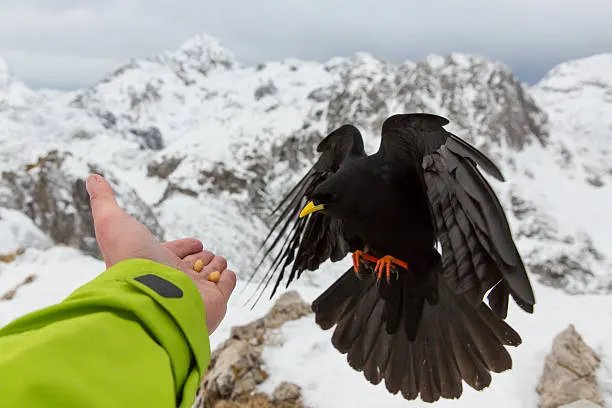
Researchers are actively engaged in studying Alpine Choughs to better understand their behavior, ecology, and adaptations. Recent studies have explored the effect of winter tourism and the presence of tourists on flocking behavior at ski resorts, shedding light on how human activities impact these high-altitude birds.
Educational and Ecotourism Opportunities
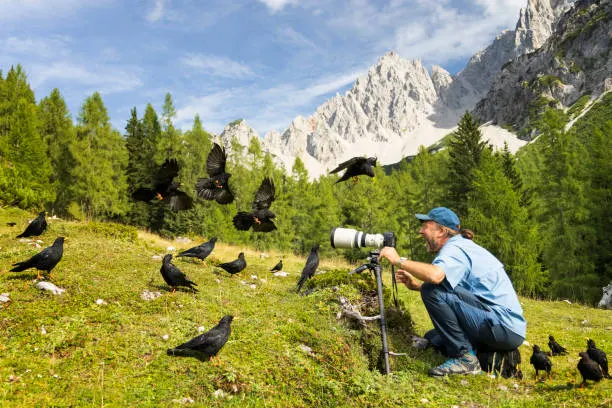
The Alpine Chough presents unique opportunities for education and ecotourism. Their presence in high-altitude tourist destinations, such as ski resorts and mountain hotels, allows visitors to observe these birds in their natural habitat. By learning about Alpine Choughs and appreciating their adaptability, tourists and enthusiasts develop a deeper connection to the diverse and resilient wildlife that thrives in extreme environments.


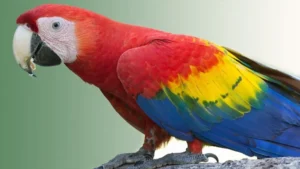
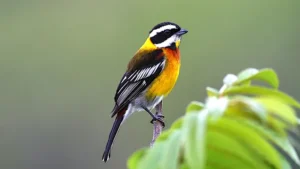
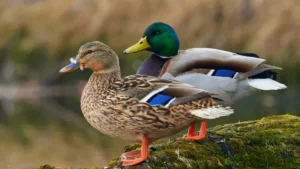


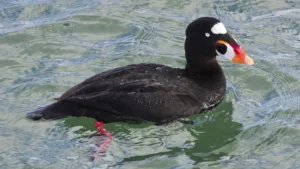

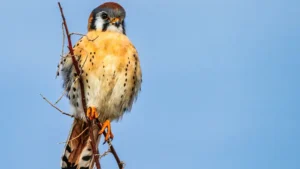

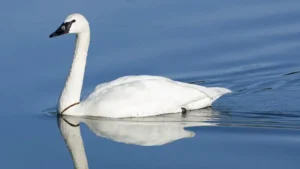
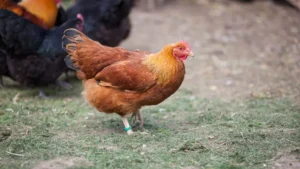
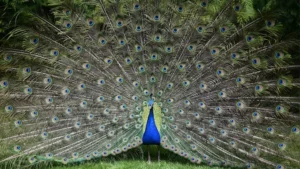
Leave your comment